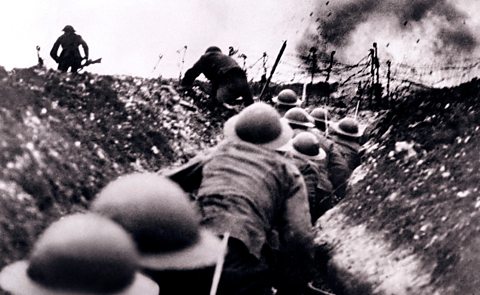World War One in the Middle East
Not all of the fighting during World War One happened in the trenches of the Western Front. Some major battles were fought for control of the Middle East.
It was here that the British Army, supported by British Empire troops from India, New Zealand and Australia, fought against the army of another empire – the Turkish Ottoman Empire.
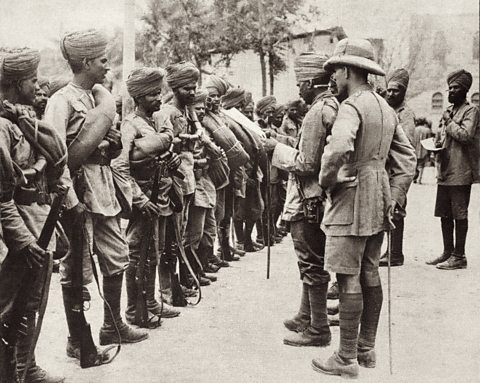 Image source, ALAMY
Image source, ALAMYHow was the Ottoman Empire involved in World War One?
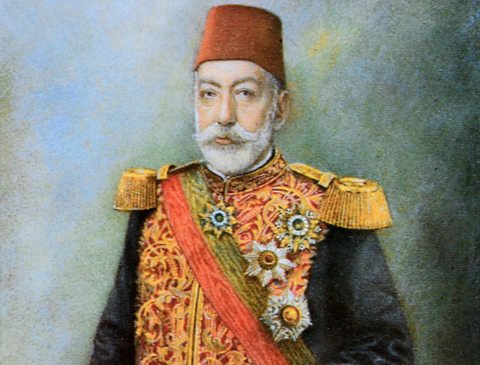 Image source, ALAMY
Image source, ALAMYFrom the 14th Century to the 20th Century, the Ottoman Empire, centred in modern-day Turkey, was one of the world’s largest and most powerful empires.
Its territories included parts of Asia, Africa, the Middle East, and Europe.
Despite its power, by 1914, the Ottoman Empire was in serious decline.
Through a long series of wars and rebellions, it lost control of important territories that were once under its control such as the Balkan nations of Greece, Bulgaria, Serbia, Montenegro, and African states such as Egypt and Tunisia.
The outbreak of World War One provided the Ottomans with a chance to reverse their empire's fortunes. In the process, however, it would bring it into conflict with another empire – the British Empire.
 Image source, ALAMY
Image source, ALAMYOttoman ambitions in WW1
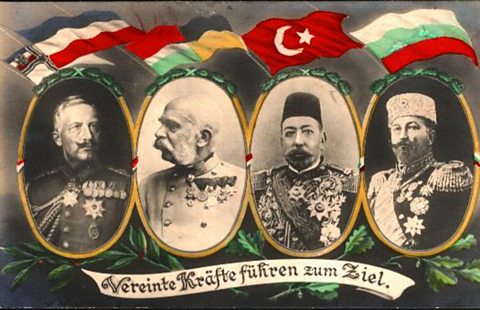 Image source, ALAMY
Image source, ALAMYWhen war was declared in 1914, the Ottoman Empire sided with the Central Powers of Germany, Austria-Hungary and Bulgaria, and abandoned its position of neutrality. On 11th November 1914, Sultan Mehmed V, constitutional head of the empire declared a war against France, Britain and Russia.
The Ottoman objective was to end the colonial dominance of these three powers and to strengthen the weakened Ottoman Empire by retaking land that had been lost in Europe and, potentially, by taking new lands to the East.
This planned expansion was a direct threat to territories that formed part of the British Empire.
 Image source, ALAMY
Image source, ALAMYOttoman threat to British interests
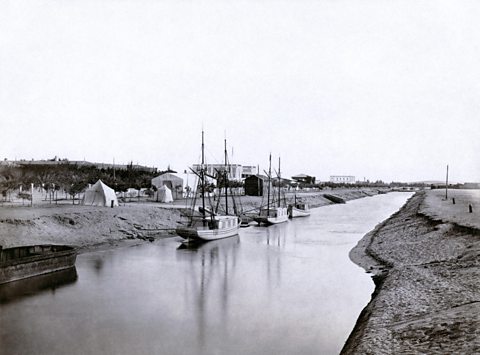 Image source, ALAMY
Image source, ALAMYThe British feared that if the Ottoman Empire were successful in defeating the Allied armies in the region, then India, still the jewel of the British Empire, would be exposed to a potential Ottoman invasion.
In addition, Ottoman forces could threaten key infrastructure that Britain relied on.
- The Anglo-Persian oil pipeline in Iran supplied Britain with fuel oil to power its navy.
- The Suez Canal in Egypt was essential to the transport of Middle Eastern oil and other supplies.
To counter the threat, an Anglo-Indian Expeditionary Force was landed at Basra in Ottoman-controlled Iraq, to defend these assets from the Ottoman threat.
 Image source, ALAMY
Image source, ALAMYWhere did soldiers in World War One come from?
 Image source, ALAMY
Image source, ALAMYThe fight for the control of the Middle East saw soldiers from all over the British Empire fight against forces from the Ottoman Empire.
The British forces included soldiers from:
- Britain
- India
- Canada
- Australia
- New Zealand
- South Africa
- Zimbabwe (then called Rhodesia)
In total, over three million men from across the territories of the British Empire fought in World War One. (Source: The National Army Museum.)
The Ottoman Army included soldiers from all the territories under Ottoman control. Although most of the soldiers were Turkish and Muslim, there was a significant minority that were Christians from other Ottoman-controlled lands.
The fighting covered much of the Middle East, including countries we now recognise as Iraq, Iran, Saudi Arabia, Palestine, Israel, Egypt, Syria, and Jordan.
With this new phase, World War One expanded from being a European war fought by European armies to a much wider conflict fought by soldiers from across the world.
 Image source, ALAMY
Image source, ALAMYWorld War One in the Middle East
Churchill's plan: Dardanelles Straight, Turkey
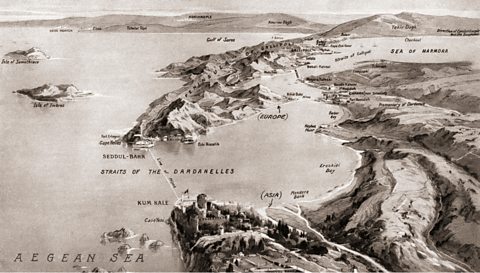 Image source, ALAMY
Image source, ALAMY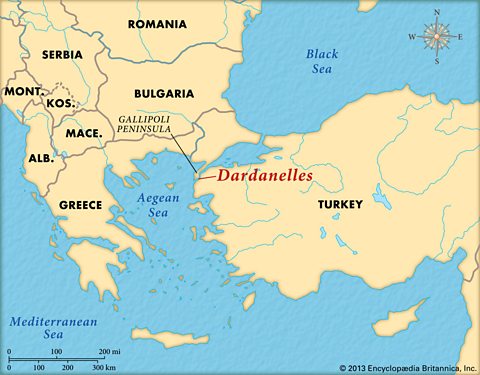 Image source, ALAMY
Image source, ALAMYWinston Churchill, at this time the First Lord of the Admiralty, planned a naval offensive against the Ottoman Empire by sailing the British Navy through the Dardanelles Strait in Turkey.
The Strait is a narrow channel that links the Black Sea and the Mediterranean Sea, and which separates Europe and Asia.
Churchill believed that by taking control of the Strait, the Allies could directly threaten the Turkish capital, Constantinople (now called Istanbul). This would prevent the Ottoman Empire from giving support to Germany. It would also allow Britain and France to support their ally Russia, via the Black Sea.
 Image source, ALAMY
Image source, ALAMYThe Gallipoli campaign, 1915
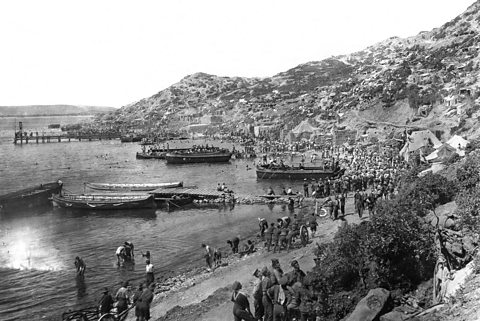 Image source, ALAMY
Image source, ALAMY Image source, ALAMY
Image source, ALAMYBritish and French ships were unable to break through Ottoman defences, so a land invasion was begun to destroy these forces. This was known as the Gallipoli Campaign.
It began with two landings of the coast of the Dardanelles Strait. This attack involved two main forces – a British Division, and an ANZACANZAC stands for the Australian and New Zealand Army Corps which was a military unit formed from soldiers from Australia and New Zealand. force. Soldiers from India, and French forces including soldiers from Senegal, Algeria and Tunisia also fought on the Allied side.
Despite the landing being supported by naval artillery, the British and ANZACs were pinned down by Ottoman forces based on higher ground.
The fighting quickly mirrored that of the Western Front as trenches were dug and the battle became one of attritionTo wear something down. A military tactic that aims to defeat an enemy by causing a high number of casualties and high level of damage..
 Image source, ALAMY
Image source, ALAMYWhy were the Allies defeated at Gallipoli?
 Image source, ALAMY
Image source, ALAMY Image source, ALAMY
Image source, ALAMYBoth sides suffered heavy casualties during the Gallipoli Campaign, from both the fighting and the conditions troops were living in.
Sickness spread through the ranks like wildfire and the extreme summer heat, not only made daily life unbearable but it also ruined food supplies, which in turn attracted clouds of black swarm flies.
After a further failed attempt to break the Ottoman ranks in August, the decision was made to evacuate the Allied troops – first the ANZACs and then the British.
By January 1916, the Gallipoli campaign was over. The British attempt to deal a swift and fatal blow to the Ottomans had failed.
Over 44,000 Allied soldiers were killed during the campaign with another 97,000 injured or seriously ill. On the Ottoman side, nearly 87,000 soldiers are thought to have died.
As a result of the role he played in spearheading the failed offensive, Churchill was demoted.
 Image source, ALAMY
Image source, ALAMYWhy were the Allies defeated in Iraq in 1916?
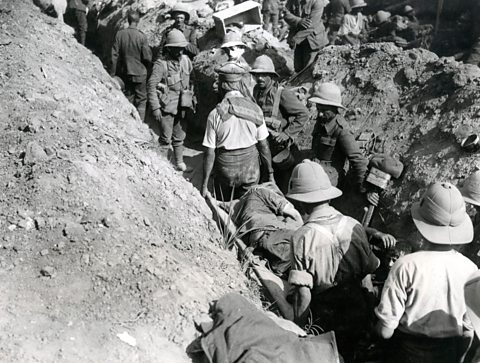 Image source, ALAMY
Image source, ALAMYAs the Gallipoli Campaign was coming to a close, the British found that they were also in trouble in Ottoman-controlled Mesopotamia (modern day Iraq).
British forces had landed on the Iraqi coast and taken control of the port city of Basra and been ordered to advance towards the capital city of Baghdad, with the objective of taking and holding onto the city.
However, the force was not equipped for such an expedition and they found themselves surrounded in a small town around 100 miles south of Baghdad.
The conditions that the troops faced were unbearable: they were constantly under attack from flies and mosquitoes, which in turn led to the spread of disease.
The men also had to endure freezing cold nights during the winter and excruciating heat as the summer approached.
The troops eventually surrendered in April 1916. The defeat as seen as a major humiliation for the British.
 Image source, ALAMY
Image source, ALAMYBritish fightback against Ottoman control in the Middle East
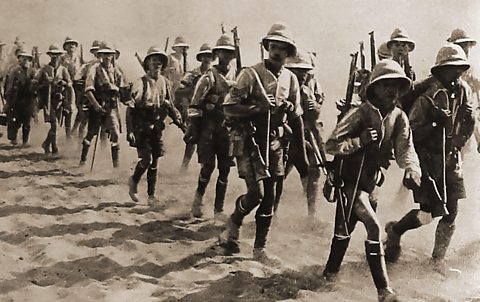 Image source, ALAMY
Image source, ALAMYThe British decided that they could not abandon the Middle East to the Ottomans and began to improve the infrastructure of the area.
The captured Iraqi port of Basra was essential because it allowed Allied forces to reinforce and resupply their armies. The port was modernised and railway lines were constructed to increase its efficiency.
This allowed the British forces to fight back and capture key Ottoman cities and territories across the Middle East.
 Image source, ALAMY
Image source, ALAMYHow was the Ottoman Army defeated in World War One?
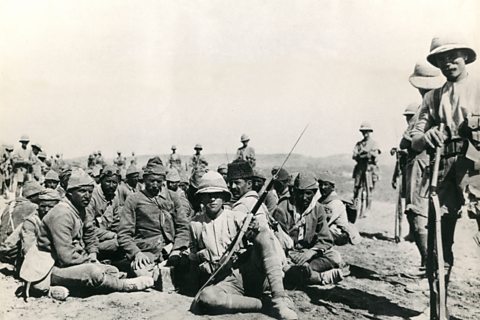 Image source, ALAMY
Image source, ALAMYA prolonged campaign saw British and Allied forces capture key cities and territories in Ottoman-controlled areas.
On 11 March 1917, British forces captured Baghdad.
The British forces arrived in Jerusalem on 11 December 1917.
In September 1918, the British launched an attack against the Ottoman forces at Megiddo in what is now Israel.
British forces quickly broke through the battered Ottoman lines and advanced over 30km on the first day.
They then pushed through gaps in the Ottoman defences and encircled them.
The Ottoman Eighth and Seventh Armies collapsed under the pressure of the Allied attack, surrendering in the tens of thousands.
This victory opened the way to Damascus, which Australian troops entered on 1 October 1918. In the weeks that followed, the Allies captured other strategically important cities to put the Ottoman forces in an extremely difficult position.
 Image source, ALAMY
Image source, ALAMYSurrender of the Ottoman Empire, 1918
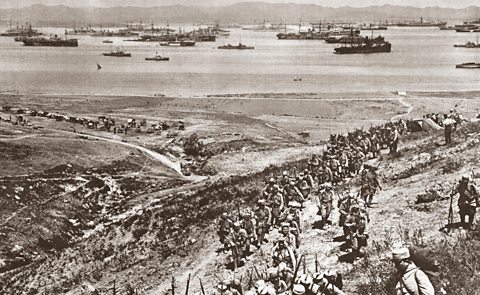 Image source, ALAMY
Image source, ALAMYWith the war clearly lost, on 30th October 1918, the Ottoman Empire sought a peace settlement with the Allies and an ArmisticeAn armistice is an agreement between two or more nations to cease fighting for a period of time. was signed at Mudros on the Greek island of Lemnos. Hostilities ceased at 12 noon the following day.
In November 1918, WW1 ended. In the years that followed, the once mighty Ottoman Empire collapsed.
First, treaties divided up former Ottoman territories and handed control of them to the Allied nations (mainly Britain, France, and Russia).
Then in 1922, the Ottoman Empire itself ceased to exist. The Emperor, Sultan Mehmet VI, abdicated and the Republic of Turkey was created.
It became the third Empire to collapse thanks to World War One, following the end of the Russian Empire in 1917, and the end of the Austro-Hungarian Empire in 1918.
 Image source, ALAMY
Image source, ALAMYTest your knowledge
More on World War One
Find out more by working through a topic
- count9 of 9
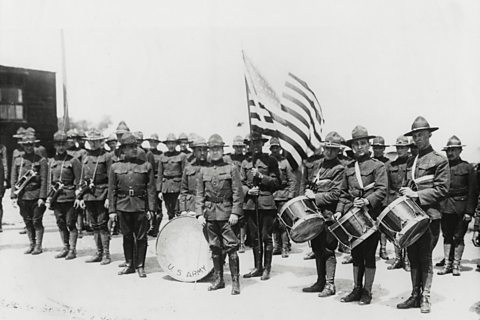
- count1 of 9
